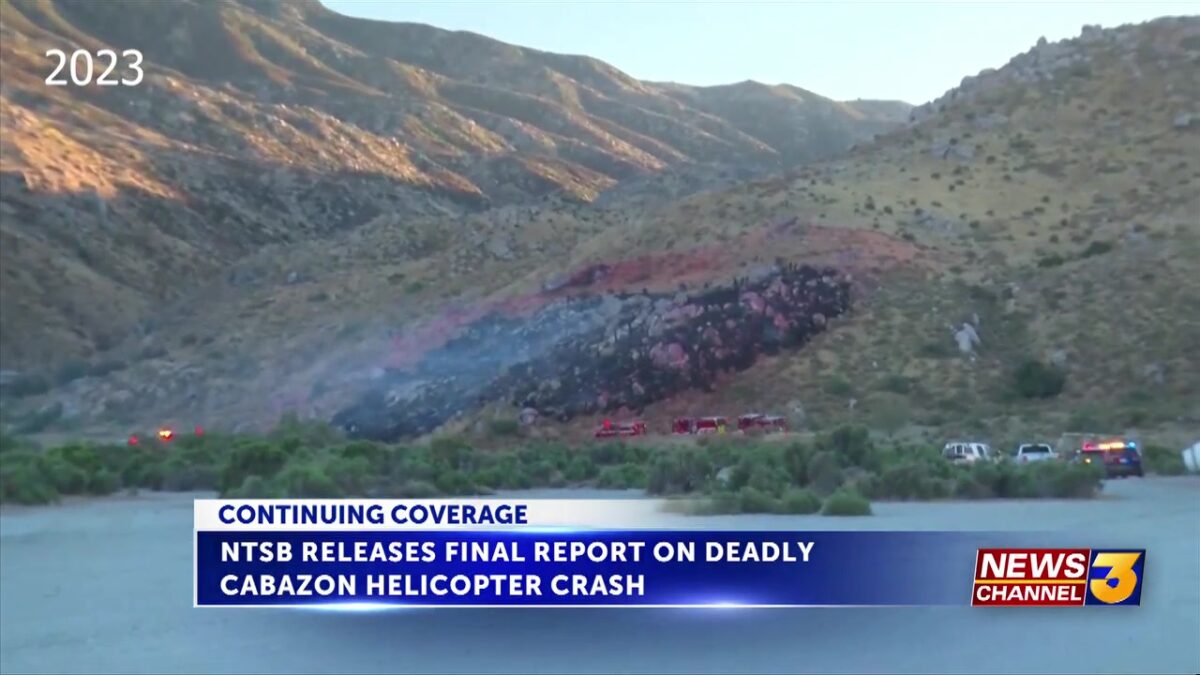NTSB releases final report on investigation into deadly Cabazon firefighter helicopter crash

Jesus Reyes
CABAZON, Calif. (KESQ) – The National Transportation Safety Board released its final report on an investigation into a helicopter crash that killed three firefighters in Cabazon in 2023.
Cal Fire Assistant Chief Josh Bischof, Fire Captain Tim Rodriguez, and contract pilot Tony Sousa were killed when two helicopters collided mid-air while battling a fire in Cabazon on Aug. 6, 2023. The second helicopter, a Skycrane helitanker, sustained minor damage, and the pilot and copilot were not injured, according to the NTSB.
Probable Cause and Findings (Per NTSB 9/11/25):
“The National Transportation Safety Board determines the probable cause(s) of this accident to be:The Skycrane flight crew’s decision to enter the Fire Traffic Area’s 7-nm NOCOM ring at analtitude significantly above their maximum cleared altitude, which resulted in their need for anaggressive descent into congested airspace and subsequent failure to see and avoid the Bell407.”
The Bell 407 and Skycrane were dispatched and departed about 3 minutes apart. The Bell 407 travelled north, skirting and staying west of the San Jacinto Mountain range between Hemet-Ryan Airport and the fire, while the Skycrane travelled northeast over the western section of the mountain range. Both helicopters were operating under FTA procedures overseen by CAL FIRE.
 Recorded ADS-B data with select communications annotated
Recorded ADS-B data with select communications annotated
According to CAL FIRE’s procedures, inbound aircraft were required to contact the Air Tactical Group Supervisor (ATGS) for permission to proceed into both the 12-nm Initial Communication Ring as well as the 7-nm No Communication (NOCOM) Ring of the FTA.
Likely due to the mountainous terrain, neither helicopter was able to receive a clear radio signal from ATGS before entering the 12-nm ring. Instead, both helicopter crews decided to maneuver to have a better line of sight for radio transmission before reaching the 7-nm ring.

Flight track data and communication recordings showed that the Bell 407 flight crew initiated a 360° turn to establish communication with ATGS before crossing the 7-nm ring. Shortly after, they descended and leveled off at the maximum assigned altitude of 2,500 ft msl, about 5 nm from the fire, where they stayed in level flight until the collision.
 ADS-B data during later part of flight with select communications annotated.
ADS-B data during later part of flight with select communications annotated.
Report_WPR23FA302_192807_9_11_2025 5_37_56 PMDownload
Following the release of the final report, CAL FIRE released a list of actions the agency has taken to prevent similar events from occurring in the future
Aviation Safety Enhancements Implemented by CAL FIRE
Enhanced Pilot Training: Developed and implemented a comprehensive training program for Exclusive Use contract helicopter pilots. This includes three modules—totaling 14 hours—covering classroom instruction, sand table exercises, and flight training focused on safety, communications, strategy, tactics, Fire Traffic Area (FTA) procedures, Base/Unit expectations, interoperability with CAL FIRE aircraft, fire scenarios, and coordination with ground resources.
Strengthened After-Action Reviews: Mandated daily AARs led by aerial and/or base supervisors, with immediate reviews required following any identified FTA policy or procedure deviations.
Empowered Aerial Supervisors: Provided tools, guidance, and authority to supervisors to adjust tactics and resource application in real time to increase operational safety.
Expanded Briefings: Broadened Helitack and Air Attack Base morning briefings to include all assigned aircraft, defining roles, departure sequencing, flight routes in controlled or congested airspace, and expected actions upon arrival at incidents.
Updated Communications Protocols: Eliminated the use of “tower” terminology for CAL FIRE aviation communication facilities, standardizing the use of discrete frequencies.
Interagency Training: Distributed interagency safety training materials and conducted enterprise-wide training, including Crew Resource Management, FTA safety, and communications. A traveling CAL FIRE team also provided in-person training to cooperating counties and partner agencies.
Strengthened Contract Requirements: Revised aircraft contracts to require Traffic Avoidance Systems and Automatic Dependent Surveillance–Broadcast In (ADS-B) technology.
Standardized FTA Checklist: Developed and distributed a detailed FTA checklist with step-by-step instructions for entering FTAs, now integrated into CAL FIRE training programs and used by all CAL FIRE flight crews and Exclusive Use contractors.
Wrongful death lawsuits have been filed on behalf of all three fallen first responders in the Superior Court of Riverside County.
“We appreciate the NTSB’s thorough investigation and findings of accountability for this completely avoidable mid-air collision. These men were on a heroic mission to save lives, and their loss was tragic not only for their families but also for their communities,” said Gary C. Robb, the aviation attorney representing the Bischof and Rodriguez families. “The public on the ground and our first responders in the air are owed diligence and due care of flight operators during these firefighting missions. The system failed them here, and the families’ greatest wish is that safety practices will be improved as a result of lessons learned here, so this never happens again.”
Robb recently served as lead counsel for Vanessa Bryant in the helicopter crash that killed her husband, NBA legend Kobe Bryant. Robb was also involved in a settlement earlier this year for another firefighting helicopter pilot killed while fighting a 2020 wildfire in Southern California.
Stay with News Channel 3 for any new developments.